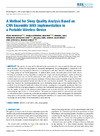Please use this identifier to cite or link to this item:
https://accedacris.ulpgc.es/handle/10553/77708
| Title: | A Method for Sleep Quality Analysis Based on CNN Ensemble With Implementation in a Portable Wireless Device | Authors: | Mendonca, Fabio Mostafa, Sheikh Shanawaz Morgado-Dias, Fernando Julia-Serda, Gabriel Ravelo García, Antonio Gabriel |
UNESCO Clasification: | 3314 Tecnología médica | Keywords: | 1DCNN CAP ECG OSA Sleep quality |
Issue Date: | 2020 | Project: | Portuguese Foundation for Science and Technology through the Projeto Estratégico under Grant LA 9—UID/EEA/50009/2019 Agência Regional para o Desenvolvimento da Investigação Tecnologia e Inovação (ARDITI) Grant M1420-09-5369-FSE-000001 Regional Government of Madeira M1420-01-0145-FEDER-000002 |
Journal: | IEEE Access | Abstract: | The quality of sleep can be affected by the occurrence of a sleep related disorder and, among these disorders, obstructive sleep apnea is commonly undiagnosed. Polysomnography is considered to be the gold standard for sleep analysis. However, it is an expensive and labor-intensive exam that is unavailable to a large group of the world population. To address these issues, the main goal of this work was to develop an automatic scoring algorithm to analyze the single-lead electrocardiogram signal, performing a minute-by-minute and an overall estimation of both quality of sleep and obstructive sleep apnea. The method employs a cross-spectral coherence technique which produces a spectrographic image that fed three one-dimensional convolutional neural networks for the classification ensemble. The predicted quality of sleep was based on the electroencephalogram cyclic alternating pattern rate, a sleep stability metric. Two methods were developed to indirectly evaluate this metric, creating two sleep quality predictions that were combined with the sleep apnea diagnosis to achieve the final global sleep quality estimation. It was verified that the quality of sleep of the nineteen tested subjects was correctly identified by the proposed model, advocating the significance of clinical analysis. The model was implemented in a non-invasive and simple to self-assemble device, producing a tool that can estimate the quality of sleep and diagnose the obstructive sleep apnea at the patient’s home without requiring the attendance of a specialized technician. Therefore, increasing the accessibility of the population to sleep analysis. | URI: | https://accedacris.ulpgc.es/handle/10553/77708 | ISSN: | 2169-3536 | DOI: | 10.1109/ACCESS.2020.3019734 | Source: | IEEE Access [ISSN 2169-3536], v. 8, p. 158523-158537 |
| Appears in Collections: | Artículos |
WEB OF SCIENCETM
Citations
4
checked on Jun 8, 2025
Page view(s)
104
checked on Mar 18, 2023
Download(s)
58
checked on Mar 18, 2023
Google ScholarTM
Check
Altmetric
Share
Export metadata
Items in accedaCRIS are protected by copyright, with all rights reserved, unless otherwise indicated.
